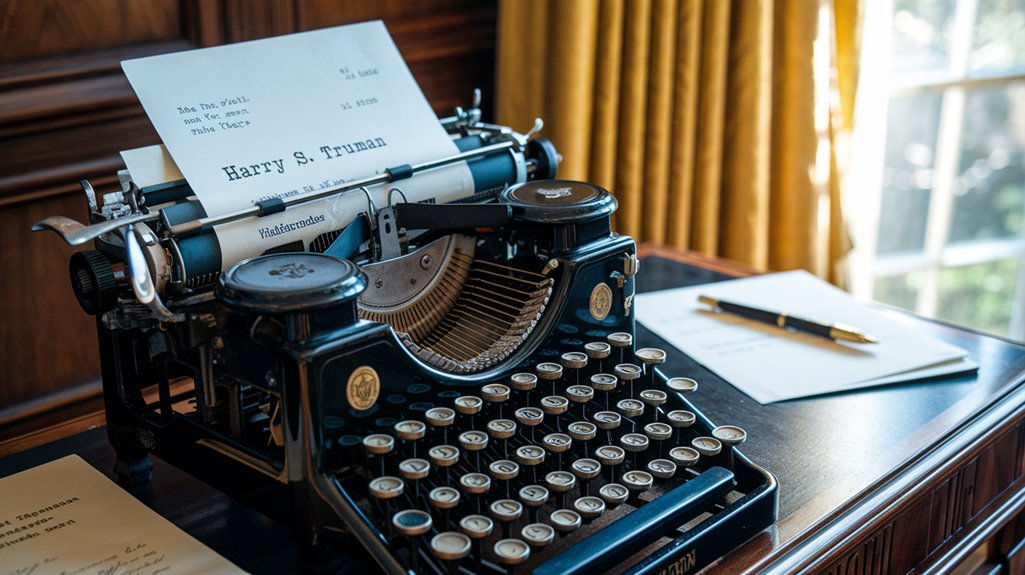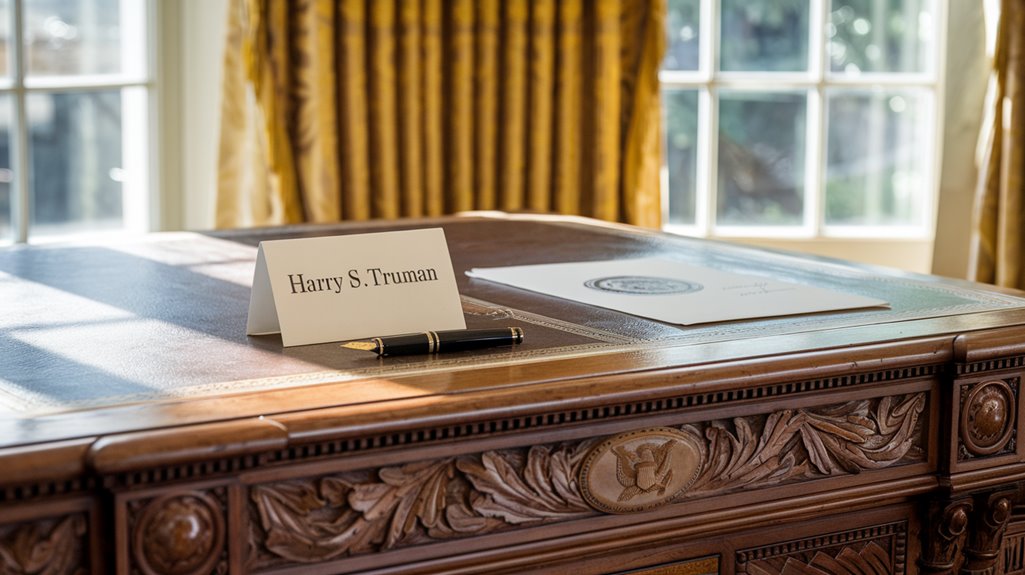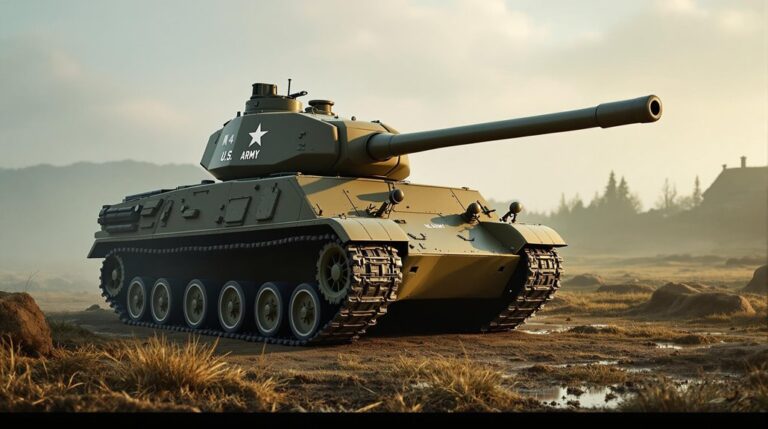Harry S Truman’s Middle Initial Doesn’t Stand for Anything
You might think every presidential name carries deep meaning, but Harry S. Truman's peculiar middle initial breaks that assumption. While most people assume the "S" stands for something specific, it actually represents a clever family compromise that tells us more about American naming customs than about the name itself. The story behind this seemingly simple initial reveals an intriguing glimpse into both Truman's family dynamics and Southern tradition's influence on American culture.
The Origins of the Mysterious "S"
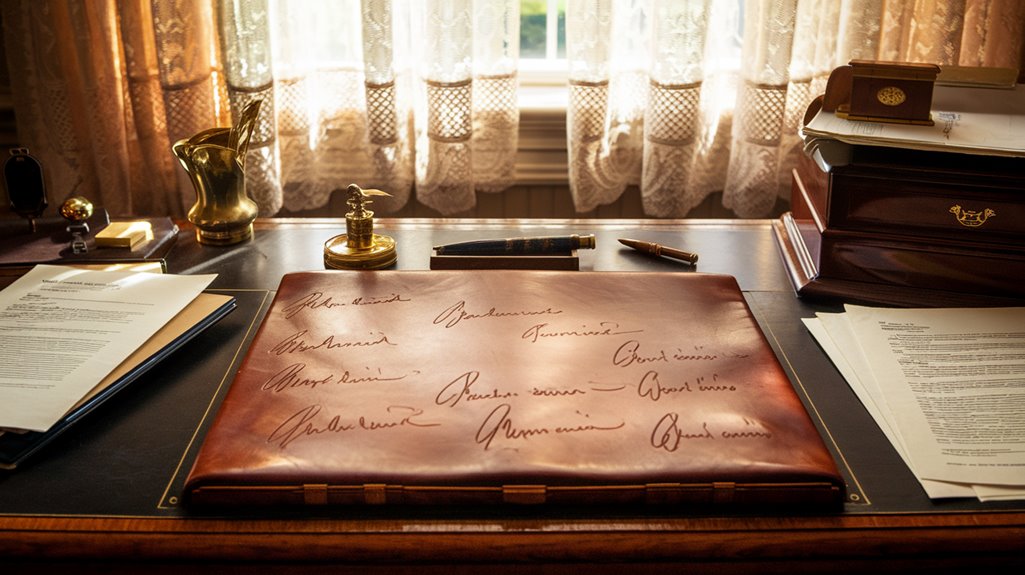
While many assume Harry S Truman's middle initial stands for a specific name, it actually represents a compromise between his two grandfathers, Anderson Shipp Truman and Solomon Young. The initial's significance reflects a common naming tradition in the American South, where using initials without corresponding full names was a cultural practice.
You'll find that this unique naming choice led to various interpretations throughout Truman's life, with people often addressing mail to him as "Harry Shipp Truman," "Harry Solomon Truman," or "Harry Simpson Truman."
Even Chief Justice Harlan F. Stone made this mistake during Truman's oath of office, referring to him as "Harry Shipp Truman." Despite these misunderstandings, Truman consistently maintained that the "S" was just an initial, though he always wrote it with a period. Born in Lamar, Missouri, Truman was raised in a family that valued education and encouraged his interests in music, history, and mathematics. He later became the nation's 33rd President following Franklin Roosevelt's death in 1945.
A Family Compromise Behind the Initial
When Harry Truman's parents chose his middle initial, they crafted a diplomatic solution to honor both sides of the family. You'll find the "S" stands as a tribute to both grandfathers – Anderson Shipp Truman and Solomon Young – without favoring either one.
This decision aligned with common family traditions of the 19th century, particularly in Southern states like Missouri, where using initials instead of full middle names was a widespread practice. Growing up in Independence, Missouri, young Truman spent most of his childhood years developing his character and interests.
You won't find any specific name attached to the "S" because it wasn't meant to represent one. Instead, it reflects the naming conventions of the era while cleverly satisfying both sides of Truman's family.
Throughout his life, Truman maintained this understanding, often correcting those who attempted to assign a full name to his middle initial. Public fascination and speculation about the meaning of his middle initial continued throughout his presidency, adding to the intrigue of his persona.
Presidential Documentation and Official Records
Since Truman's presidency predated modern record-keeping laws, you'll find his documents managed differently than those of recent presidents.
Today's Presidential Records Act, established in 1978, guarantees that all presidential records belong to the American people and transfers to the National Archives when a president leaves office.
Interestingly, during Truman's inauguration in 1945, Chief Justice Harlan F. Stone made history by incorrectly assigning Shipp as his middle name.
If you visit Presidential Archives now, you'll find strict guidelines for Record Preservation, including detailed processes for handling everything from memos to emails.
You'll see how NARA oversees the transfer of millions of documents to presidential libraries, where they become accessible through FOIA requests after a five-year waiting period.
This systematic approach differs considerably from Truman's era when presidents maintained greater control over their administrative papers and personal records.
Common Misconceptions and Public Theories
Throughout American history, numerous myths have circled Harry S Truman's middle initial. You'll find many people wrongly believing the "S" stands for names like Solomon, Shipp, or Simpson, each tied to various theories about Truman's identity.
One persistent myth suggests the initial honors both his grandfathers, Anderson Shipp Truman and Solomon Young, though no evidence supports this claim. In fact, Truman's parents could not decide between the two grandfathers' names. Some political rivals even spread a theory that suggested the "S" stood for Solomon to imply Jewish heritage.
The historical significance of this misunderstanding extends to official contexts, where even Chief Justice Harlan F. Stone made a mistake during Truman's inauguration.
Despite widespread speculation and various symbolic interpretations, including claims that "S" represents "statesman" or "soldier," Truman himself clarified that his middle initial stands for nothing specific.
The confusion continues today, though experts and the Truman Library consistently maintain this simple truth.
The Cultural Impact of Truman's Middle Initial
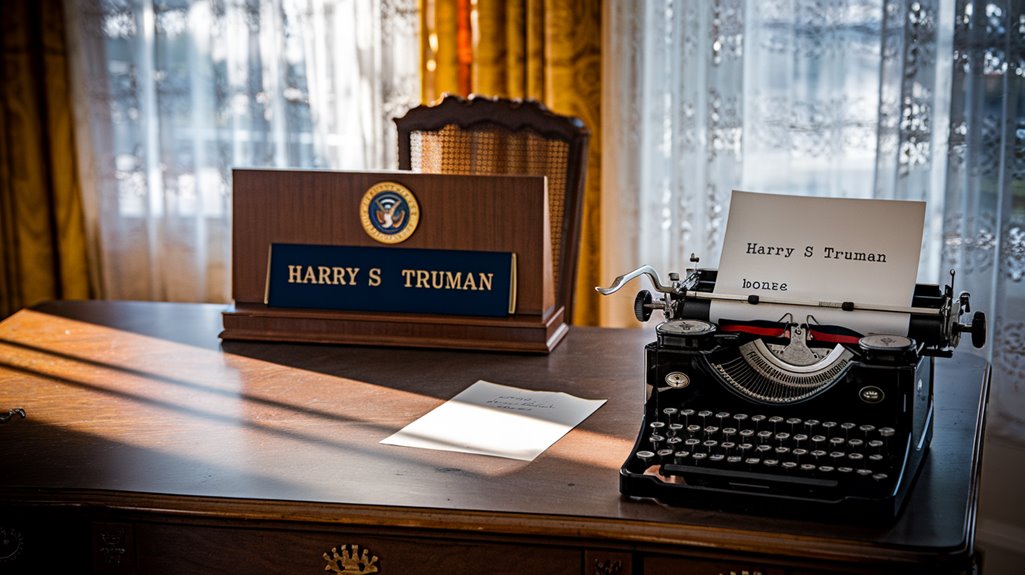
Simplicity marked Harry S Truman's middle initial, reflecting a common cultural practice among rural American families in the late 19th and early 20th centuries. This naming tradition, where families used single initials without specific names, showcased their modest backgrounds and desire to honor both family lines equally.
You'll find that Truman's middle initial had lasting cultural significance beyond his presidency. It sparked ongoing debates about grammar, particularly regarding the use of a period after the 'S'.
While Truman himself wasn't consistent with the period, the Chicago Style Manual recommended its use, and the Harry S. Truman Library adopted this convention. Notably, he only began using a period after the 'S' once the Chicago Style Manual informed him of the proper punctuation.
The initial also symbolizes his straightforward approach to leadership and continues to remind us how personal identity intertwines with cultural traditions.
Historical Precedents and Similar Presidential Cases
While Truman's standalone "S" initial stands out in presidential history, he wasn't alone in having distinctive middle name characteristics. Early U.S. presidents, including George Washington and John Adams, didn't have middle names at all. The "S" in Truman's name honors both grandfathers.
As naming conventions evolved, middle names became more common, often honoring family heritage or distinguishing individuals with similar names. Grant's real name at birth was Hiram Ulysses Grant, but a clerical error at West Point changed it.
You'll find other interesting cases throughout presidential history. Ulysses S. Grant faced similar confusion over his middle initial, while Franklin Pierce's "K" remains a mystery.
Some presidents, like Woodrow Wilson and Grover Cleveland, chose to use their middle names as their primary identifiers. This pattern of unique middle name usage reflects the changing American naming practices, where middle names transformed from being rare to becoming an essential part of personal identity.

